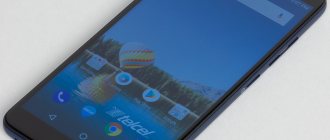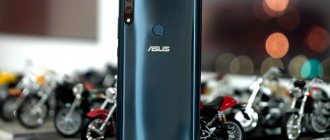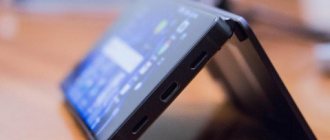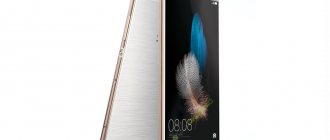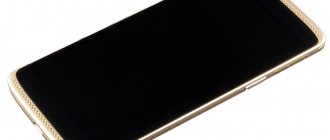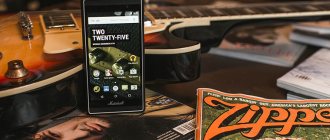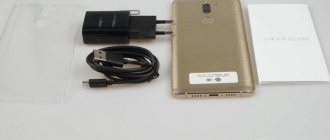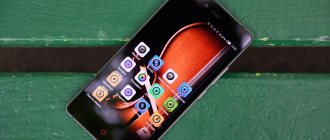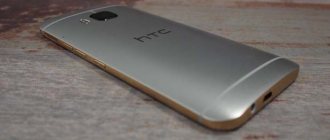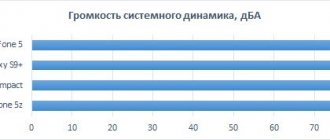It used to be like this: when purchasing a mid-price Android smartphone, the buyer received a rather faceless device with a completely standard, unremarkable exterior, but give or take good technical characteristics. We are not talking about the fact that back then all middle-end gadgets were ugly or unattractive. No, they were just very similar. Now many first-tier manufacturers have begun making inexpensive gadgets with an interesting appearance, but rather boring characteristics. Whatever one may say, you have to choose: either one or the other, and there are not very many compromise solutions that combine an interesting design and decent hardware in this price category. In theory, the ZTE Blade V7, which sells for 15 thousand rubles, could become just that.
ZTE Blade V7 – official image
⇡#Technical characteristics
| ZTE Blade V7 | Meizu M3 Note | LG X view | Lenovo VIBE P1 | ASUS Zenfone 2 (ZE551ML) | |
| Screen | 5.2 inches, 1920 × 1080 pixels, IPS; capacitive, up to five simultaneous touches | 5.5 inches, 1080 × 1920 pixels, IPS; capacitive, up to ten simultaneous touches | 4.93 inches, 720 × 1280 pixels, IPS; capacitive, up to ten simultaneous touches | 5.5 inches, 1080 × 1920 pixels, IPS; capacitive, up to ten simultaneous touches | 5.5 inches, 1080 × 1920 pixels, IPS; capacitive, up to ten simultaneous touches |
| Additional screen | No | No | 1.76 inches, 80 × 520 pixels, IPS; capacitive, multi-touch, gesture support | No | No |
| Protective glass | Yes, (manufacturer unknown), with oleophobic coating and polarizing filter | Dinorex T2X-1, with oleophobic coating and polarizing filter | Yes (manufacturer unknown), with oleophobic coating and polarizing filter | Corning Gorilla Glass 3, with oleophobic coating and polarizing filter | Corning Gorilla Glass 3, with oleophobic coating and polarizing filter |
| CPU | MediaTek MT6753: eight cores ARM Cortex-A53, frequency 1.3 GHz; process technology: 28 nm | MediaTek MT6755 Helio P10: four ARM Cortex-A53 cores, 1.0 GHz + four ARM Cortex-A53 cores, 1.8 GHz; process technology: 28 nm | Qualcomm Snapdragon 410 MSM8916: four ARM Cortex-A53 cores, 1.21 GHz; process technology: 28 nm | Qualcomm Snapdragon 615 MSM8939: four ARM Cortex-A53 cores, 1.11 GHz + four ARM Cortex-A53 cores, 1.46 GHz; Process technology: 28 nm LP | Intel Atom Z3580: four cores of Tangier architecture (x86-64), frequency 2.33 GHz; process technology: 22 nm |
| Graphics controller | ARM Mali-T720MP2, frequency 600 MHz | ARM Mali-T860MP2, frequency 600 MHz | Qualcomm Adreno 306, 400 MHz | Qualcomm Adreno 405, 550 MHz | Imagination Technologies PowerVR Rogue G6430, 533 MHz |
| RAM | 2 GB LPDDR3 | 2/3 GB LPDDR3 (we have a 2 GB version on test) | 2 GB LPDDR3 | 2 GB LPDDR3 | 4 GB LPDDR3 |
| Flash memory | 16 GB (11.7 GB available to user) + microSD | 16/32 GB (we tested the 16 GB version; 11.1 GB are available to the user) + microSD | 16 GB (11.3 GB available to user) + microSD | 32 GB (25.2 GB available to user) + microSD | 32 GB (25.5 GB available to user) + microSD + 5 GB cloud storage ASUS WebStorage |
| Connectors | 1 × micro-USB 2.0 | 1 × micro-USB 2.0 | 1 × micro-USB 2.0 | 1 × micro-USB 2.0 | 1 × micro-USB 2.0; |
| 1 × 3.5mm headset jack | 1 × 3.5mm headset jack | 1 × 3.5mm headset jack | 1 × 3.5mm headset jack | 1 × 3.5mm headset jack; | |
| 1 × Nano-SIM | 1 × Nano-SIM | 1 × Nano-SIM | 1 × microSD (SDHC/SDXC); | 1 × microSD (SDHC/SDXC); | |
| 1 × Nano-SIM/microSD (universal) | 1 × Nano-SIM/microSD (universal) | 1 × Nano-SIM/microSD (universal) | 2 × Nano-SIM | 2 × Micro-SIM | |
| SIM cards | Two Nano-SIM format SIM cards | Two Nano-SIM format SIM cards | Two Nano-SIM format SIM cards | Two Nano-SIM format SIM cards | Two SIM cards in Micro-SIM format |
| Cellular connection 2G | GSM/GPRS/EDGE 850/900/1800/1900 MHz | GSM/GPRS/EDGE 850/900/1800/1900 MHz | GSM/GPRS/EDGE 850/900/1800/1900 MHz | GSM/GPRS/EDGE 850/900/1800/1900 MHz | GSM/GPRS/EDGE 850/900/1800/1900 MHz |
| Cellular 3G | DC-HSPA (42 Mbps) 900/2100 MHz | DC-HSPA (42 Mbps) 850/900/1900/2100 MHz | DC-HSPA (42 Mbps) 850/900/1900/2100 MHz | DC-HSPA (42 Mbps) 850/900/1900/2100 MHz | DC-HSPA (42 Mbps) 850/900/1900/2100 MHz |
| Cellular 4G | LTE Cat. 4 (150 Mbit/s, 50 Mbit/s); | LTE Cat. 6 (300 Mbit/s, 50 Mbit/s); | LTE Cat. 4 (150 Mbit/s, 50 Mbit/s); | LTE Cat. 4 (150 Mbit/s, 50 Mbit/s); | LTE Cat. 4 (150 Mbit/s, 50 Mbit/s); |
| FDD LTE: band 1, 3, 7, 8 | FDD LTE: band 1, 3, 7, 38, 39, 40, 41 | FDD LTE: band 1, 3, 7, 8, 20 | FDD LTE: band 1, 3, 7, 20; TDD LTE: band 40 | FDD LTE: band 1, 2, 3, 4, 5, 7, 8, 9, 17, 18, 19, 20, 28, 29; TDD LTE: 38, 39, 40, 41 | |
| WiFi | 802.11b/g/n, 2.4 GHz + Wi-Fi Direct | 802.11a/b/g/n 2.4/5 GHz + Wi-Fi Direct | 802.11b/g/n, 2.4 GHz + Wi-Fi Direct | 802.11a/b/g/n 2.4/5 GHz + Wi-Fi Direct | 802.11a/b/g/n 2.4/5 GHz + Wi-Fi Direct |
| Bluetooth | 4 | 4 | 4.1 | 4.1 | 4 |
| NFC | No | No | No | Eat | Eat |
| IR port | No | No | No | No | No |
| Navigation | GPS, A-GPS, GLONASS | GPS, A-GPS, GLONASS, BeiDou | GPS, A-GPS, GLONASS, BeiDou | GPS, A-GPS, GLONASS, BeiDou | GPS, A-GPS, GLONASS |
| Sensors | Illumination, proximity, accelerometer/gyroscope, magnetometer (digital compass), pedometer | Illumination, proximity, accelerometer/gyroscope, magnetometer (digital compass), pedometer | Illumination, proximity, accelerometer/gyroscope, magnetometer (digital compass) | Illumination, proximity, accelerometer/gyroscope, magnetometer (digital compass) | Illumination, proximity, accelerometer/gyroscope, magnetometer (digital compass) |
| Fingerprint's scanner | No | Eat | No | Eat | No |
| Main camera | 13 MP (4160 × 3120), f/2.2 aperture, autofocus, single LED flash | 13 MP (4160 × 3120), f/2.2 aperture, autofocus, dual LED flash | 13 MP (4160 × 3120), f/2.2 aperture, autofocus, single LED flash | 13 MP (4160 × 3120), relative aperture f/2.2, autofocus, optical stabilization system, dual LED flash | 12.6 MP (4096 × 3072), PixelMaster technology, f/2.0 aperture, autofocus, LED flash |
| Front-camera | 8 MP (3264 × 2448), no autofocus, no flash | 5 MP (2592 × 1944), no autofocus, no flash | 8 MP (3264 × 2448), no autofocus, no flash | 5 MP (2592 × 1944), no autofocus, no flash | 4.9 MP (2560 × 1920), no autofocus, no flash |
| Nutrition | Non-removable battery: 9.65 Wh (2540 mAh, 3.8 V) | Non-removable battery: 15.58 Wh (4100 mAh, 3.8 V) | Non-removable battery: 8.74 Wh (2300 mAh, 3.8 V) | Non-removable battery: 19 Wh (5000 mAh, 3.8 V) | Non-removable battery: 11.4 Wh (3000 mAh, 3.8 V) |
| Size | 146 × 73 × 7.9 mm | 153 × 75 × 8.2 mm | 142 × 72 × 7.1 mm | 153 × 75 × 9.9 mm | 152 × 77 × 10.9 mm |
| Weight | 136 g | 163 g | 120 g | 189 g | 170 g |
| Water and dust protection | No | No | No | No | No |
| operating system | Android 6.0 Marshmallow, own MiFavor UI shell | Android 6.0 Marshmallow, Meizu's own Flyme UI shell | Android 6.0 Marshmallow, LG's own shell | Android 5.1.1 Lollipop, Lenovo's own shell | Android 5.0 Lollipop, ASUS ZenUI Shell |
| Current price | 15,990 rubles | 16,990 rubles for the 16 GB version; 18,990 rubles for the 32 GB version | 17,990 rubles | 19,990 rubles | 23,490 rubles |
| ZTE Blade V7 – information about the system and hardware according to the CPU-Z application | ||||
ZTE Blade V7 Lite
This smartphone needs to be studied, first of all, by comparing its technical characteristics with the original version. Below is a sign where I have highlighted the improvements in green and the things that have worsened in red. Yes, I was not mistaken. The advanced version has its own controversial issues.
| ZTE Blade V7 Lite | ZTE Blade V7 | |
| CPU | MediaTek MT6735P (4 cores Cortex-A53, 64-bit) | MediaTek MT6753 (8 cores Cortex-A53, 64-bit) with a frequency of 1.3 GHz |
| Video chip | Mali-T720 MP2 | Mali-T720 MP3 |
| RAM | 2 GB | 2 GB (920 MB free) |
| Built-in memory | 16 GB | 16 GB (9.63 GB storage available) |
| Memory card support | Yes, Micro SD | Yes, Micro SD |
| Display | 5 inches, 1280 x 720 pixels, 294 ppi | 5.2 inches, 1920 x 1080 pixels, 424 ppi |
| Main camera | 8 MP | 13 MP (phase autofocus, focusing speed up to 0.3 s, dual flash) |
| Front-camera | 8 MP | 5 MP |
| Battery | 2500 mAh | 2500 mAh |
| OS | Android 6.0 | Android 6.0 |
| Networks | 2G, 3G, 4G | 2G, 3G, 4G (LTE bands 1, 3, 7, 8, 20) |
| Wireless interfaces | Wi-Fi (802.11 b/g/n), Bluetooth 4.0, FM radio | Wi-Fi (802.11 b/g/n), Bluetooth 4.0, FM radio |
| Geolocation | A-GPS, GPS | A-GPS, GPS |
| Sensors | Light and proximity sensor, accelerometer, hall sensor, fingerprint scanner | Light and proximity sensor, accelerometer, hall sensor, gyroscope, no fingerprint scanner |
| Connectors | Micro USB (OTG not confirmed), 3.5 mm audio output | Micro USB (OTG works), 3.5 mm audio output |
| Case colors | Gray only | Gray and gold |
| Water and dust protection | No | No |
| Dimensions | 143.8 x 70.2 x 7.9 mm | 146 h 72.5 x 7.5 mm |
| Price | 189,00 $ | 249,00 $ |
The V7 Lite, with its specifications, is suspiciously reminiscent of the Blade V6 (or X7 in Russia), which in turn was shown at IFA 2020. Material about this device can be read here.
Let's return to our heroes. The “light” version received an HD screen (1280 x 720), but this is not at all critical. With a screen diagonal of 5 inches, it is difficult to make out individual pixels; fonts, icons - everything looks smooth. The problem is that the protective glass does not have an oleophobic coating. And this is what the phone will look like most of the time.
Stained screen of ZTE Blade V7 Lite
It is quite difficult to clean it from greasy fingerprints. You need to diligently breathe on the screen and only then use the cloth. It is very sad when smartphone models without oleophobic coating enter the market in 2020. Especially given the fact that the vast majority of the same Chinese, cheaper than $200, have been using such coatings for a long time.
Surprisingly, Russia is the first country where sales of the ZTE Blade V7 Lite . This will happen this spring. Afterwards the device will appear in Spain, Germany, Thailand and other countries.
Let's move on to a more advanced, and therefore more interesting device.
⇡#Appearance and ergonomics
The new ZTE smartphone is made of aluminum, which is still rare in the middle price segment. The body of the device is non-separable and relatively strong - when you squeeze the sides, there are no characteristic colored “stains”, but when you press from above, we can see them. However, you need to try for this. There are enough stiffening ribs in the design; we have no complaints about the assembly.
ZTE Blade V7 – front panel
The body dimensions of the Blade V7 are quite standard for an Android smartphone with a 5.2-inch screen diagonal. The bezels around the display are not very wide. Due to this, it is quite comfortable to operate the device with one hand. Your thumb can easily reach any point on the screen; you don’t have to place the device in your palm.
ZTE Blade V7 – front panel
The screen is protected from damage using so-called 2.5D glass. From an ergonomic point of view, everything is standard here: at the top of the panel there is a speaker, an LED indicator and a front camera lens, at the bottom there are system navigation keys. It is noteworthy that the latter are equipped with backlighting, making them convenient to use in the dark.
ZTE Blade V7 – “Back”, “Home” and “Open Applications Menu” keys (can be arranged in any order through the settings menu)
By the way, the ZTE Blade V7 does not have one of the main trends of 2020 - a fingerprint scanner. In the middle-end segment, the fingerprint sensor remains the exception rather than the rule, which, of course, will change next year.
ZTE Blade V7 – front camera
The thickness of the device's case is 7.9 millimeters, but due to the curves it seems that the device is slimmer than it actually is. The device weighs 136 grams - not very much, your hands don’t get tired of it.
| ZTE Blade V7 – location of interfaces and connectors | ||
The power button of the device is embossed and pleasant to press. It is located on the right side. Next to it is a slot for two cards. You can install either two Nano-SIMs or one SIM card and one microSD into the device. As always in such cases, we complain that there is no separate slot for a memory card. The volume control keys are on the left side. The headset connector is located on the top edge, the micro-USB interface is on the bottom. Next to the latter there is a slot for an external speaker. The location is good - the speaker is not blocked by the palm either when the device is lying on the table or when it is in the hands.
ZTE Blade V7 – rear panel
The back panel is rough, thanks to which the Blade V7 does not slip even in a wet palm. It does not collect fingerprints - the device turned out to be practical. The plastic inserts in the upper and lower parts of the “back” fit perfectly - they do not creak or play. The device comes in three colors: gray, graphite and gold.
Review of ZTE Blade V7 Lite
ZTE is a Chinese company that is one of the largest mobile phone manufacturers in China. In Russia, smartphones from this manufacturer are also very popular due to the optimal combination of price, quality and reliability.
Characteristics of the ZTE Blade V7 Lite smartphone
- Operating system - Android 6.0;
- SIM card - nano SIM (supports two SIM cards or one SIM card and a MicroSD flash card up to 32 GB);
- Size (WxHxT) - 70.2×143.8×7.9 mm;
- Screen type – touch, color IPS, 16.78 million colors;
- Screen diagonal - 5 inches;
- Screen resolution - 1280x720 pixels;
- Pixels per inch (PPI) – 294;
- Main camera – 13 megapixels with autofocus and LED flash;
- Front camera - 8 megapixels, also with flash;
- Processor – MediaTek MT6735P, 4 cores, 1000 MHz;
- Video processor - Mali-T720;
- Internal memory capacity is 16 GB (about 5 GB is reserved by the system, so please note that there will be approximately 11 GB for user data);
- RAM capacity - 2 GB;
- Communication - GSM 900/1800/1900, 3G, 4G LTE;
- Interfaces - Wi-Fi 802.11n, Bluetooth 4.0, USB;
- Satellite navigation - GPS/GLONASS;
- A-GPS system – yes;
- Headphone jack – 3.5 mm;
- Battery – non-removable with a capacity of 2500 mAh;
- Charging connector type: micro-USB.
Features of ZTE Blade V7 Lite
Features of the ZTE Blade V7 Lite include the presence of a fingerprint scanner, which is rare in this price category; this advantage is mainly enjoyed by smartphones from Chinese manufacturers or premium smartphones from branded manufacturers.
This model also has voice dialing, voice control, light and proximity sensors, gesture control, even a flashlight, and that is.
The model is equipped with a charger and simple headphones, there is nothing else additional.
Also, the features of the ZTE Blade V7 Lite include the fact that this model is quite light and thin, while the smartphone is convenient to use.
⇡#Display
The resolution of the 5.2-inch screen of the ZTE Blade V7 is Full HD (1920 × 1080 pixels). The pixel density is high – 423.6 pixels per inch. This value is more than enough to completely get rid of the notorious “pixelation” effect. The text, even small ones, looks quite sharp - reading electronic documents on the screen of this smartphone is very comfortable. For movies and photographs, the resolution is, of course, sufficient.
The screen is made using IPS technology. You can look at it at an angle: the characteristic drop in contrast when looking away from the perpendicular is moderately expressed here. Blacks don't turn dark purple or gray, so two people can watch videos on the Blade V7 display. The device is very responsive; it responds to touch quickly and accurately. The device supports up to five simultaneous clicks and easily recognizes multi-touch gestures. The gadget can be used with loose gloves, which will soon become very important.
The screen is made very well: there is no air gap between the protective glass of the front panel and the matrix. A very effective polarizing filter also helps combat glare. By the way, the glass here has an oleophobic coating, so it is pleasant to the touch and is easy to clean from any dirt and fingerprints.
The backlight frames of the Blade V7 display are quite wide. The minimum luminosity of the white field is 13 cd/m2, the maximum is 468 cd/m2. This is a fairly large spread, which is, of course, good. Thanks to this, the device can be used equally comfortably both in complete darkness and in direct sunlight. You can entrust brightness control directly to the smartphone itself - it is equipped with a light sensor. It copes with this task well - the backlight level is adjusted smoothly and accurately.
The static contrast ratio of the V7 screen is also relatively high - 1019:1. For a mid-price smartphone, this is a very decent figure.
ZTE Blade V7 – Grayscale Color Temperature
The V7's grayscale color balance isn't as carefully tuned as it should be. On average, the color temperature is 8 thousand Kelvin, and on a completely white color it exceeds 8500 K. This is significantly higher than the reference value; the picture on the screen has a cold tint. But the ZTE proprietary shell has a built-in MiraVision software filter set, thanks to which the user can adjust not only color temperature, but also contrast, saturation and a number of other parameters to his preferences.
| ZTE Blade V7 – MiraVision filters | ||||
All gamma curves – both color components and gray – are close to the standard, which is very good. The exception, however, was the blue curve. However, with such a default color temperature, this is not at all surprising.
| ZTE Blade V7 – gamma curve of grayscale (left) and color components (right) in comparison with the reference curve (indicated by a dotted line on the graphs) | ||
The triangle shape of the color gamut differs slightly from the sRGB reference color space. In particular, the green color tends somewhat towards light green. However, in practice this does not particularly interfere with comfortable work with the device. Let us remind you that the color rendering here can be almost completely customized to suit you.
ZTE Blade V7 – smartphone screen color gamut (white triangle) compared to the sRGB reference space (black triangle)
Review of ZTE Blade V7 and its comparison with Samsung Galaxy J5 (2016)
» Specifications ZTE Blade V7
Appearance
As they say, “you meet people by their clothes.” Let's look at the box. The packaging design, in my opinion, has changed and become better. In the box you can find a power supply with a cable for connecting to a computer, a manual and a “clip” (a key to remove the SIM card tray).
The body of the smartphone is metal, the specifications indicate that it is made of aluminum. The case is non-separable, which affects its strength. The assembly is “at the level” - nothing creaks or plays. There are plastic pads on the top and bottom of the back that appear to be designed for better connectivity.
The phone size is the most standard: 5.2-inch screen, with a medium-width frame. If your fingers are not short, then you can easily operate with one hand.
The screen is protected by 2.5D glass - smooth edges are pleasant to the touch. Apparently, the glass has a good oleophobic coating, as a result of which prints can be easily wiped off with a napkin. Otherwise, the front side looks standard - three touch buttons at the bottom, a speaker with a camera at the top. By the way, the touch buttons are backlit. There is also a message indicator in the top left corner.
The display has FullHD resolution, which gives a high pixel density. Good viewing angles are provided by an IPS matrix made using OGS technology (without an air gap between the touch glass and the matrix). The smartphone uses MiraVision screen technology, which allows you to adjust brightness, contrast, saturation and color temperature.
The lock button and SIM card tray are on the right, and the volume buttons are on the left.
At the top there is a jack for connecting a headset or headphones. The bottom end is “copied” from the iPhone - a speaker, microphone and charging connector.
I was pleased with the back panel - it is matte and does not slip in the hand. What’s remarkable is that there are no fingerprints left on it.
The touch screen supports five simultaneous touches.
Comparison with Samsung Galaxy J5
The ZTE Blade V7 smartphone can be compared with the Samsung Galaxy J5 (2016) according to several criteria (price, appearance, characteristics). At retailers they cost almost the same. How does the ZTE device differ from the “more branded” Samsung?
Appearance
The sizes and appearance are almost the same. But here it’s all about the details. For example, ZTE's 2.5D glass looks nicer due to its rounder edges. ZTE's cover is not as easily soiled as Samsung's.
Screen
The matrices of the ZTE Blade V7 and Samsung Galaxy J5 are made using different technologies. If ZTE uses IPS, then Samsung uses sAMOLED. Both technologies have their pros and cons. If you don’t go into technical terms, the difference is insignificant - basically the color rendition is slightly different. The J5's Super AMOLED is slightly more economical and produces high-quality blacks, while IPS produces “true” whites. Brightness and viewing angles are approximately the same.
Other
The software is almost the same: Android 6 and several proprietary applications.
If you compare the characteristics of V7 from J5, you can see:
- J5 has only 4 cores, unlike V7 which has 8 cores.
- The V7's front camera has more megapixels (8 versus 5).
- The battery is 600mAh smaller than the J5.
- The screen is different. Samsung's screen is made using SuperAMOLED technology and has an HD 720p resolution.
Results
In terms of characteristics and appearance, Samsung loses. Both devices work quickly, but in “cool” games they slow down, but in practice the J5 has some advantages: the J5’s camera works much better (photos are better under the same conditions), GPS works stable and fast, has longer battery life, has NFC (wireless payment) ).
Software part (OS and installed applications)
It runs an Android 6 smartphone with ZTE's MiFavor shell. Everything works smoothly and quickly, there are no slowdowns or freezes. Android is almost no different from many other devices. The smartphone has standard applications (calculator, gallery, Google suite), several applications from ZTE (Support, Backup) and a couple of useful applications (antivirus and memory cleaner application).
In the settings, you can swap the positions of the side touch buttons and enable control gestures.
The windows with application requests to the phone’s internal resources (camera, memory, messages, etc.) are a little annoying. Some applications refuse to open or perform certain functions until you add permissions for the application in the settings. But this is rather a feature of the sixth Android, which was done for the security of the OS.
Photo
The ZTE Blade V7 phone has two cameras: 13 megapixels - the main one and 8 - the front one. The cameras are standard for smartphones, but the photo quality is terrible. The front camera does not have autofocus and is only intended for video calls.
The main camera only takes good pictures in very good lighting. In room lighting, noise appears, autofocus begins to miss, and photographs may be blurry. You can change some parameters in the settings, but the quality will not improve. To get a good photo you need to be “confused.”
So we won’t dwell on the camera, we’ll just show a few photos of an attempt to photograph a cat in a room.
Hardware
ZTE Blade V7 is powered by a MediaTek MT6753 chip with a Mali-T720MP2 video accelerator. These are eight cores with a frequency of 1.3 GHz, 2 GB RAM.
AnTuTu Benchmark v6.1 produces about 3FPS; normal game requires more than 30FPS.
Antutu Benchmark v6.2.1 shows 33,217 points.
The game Asphalt 8 is slow, the phone is clearly too weak for this game. There are no problems with video - FullHD videos open and play without any lag.
There is enough hardware to easily carry out any daily activities (calls, communication on social networks, searching for information in the browser) and play not very demanding games. New “cool” games, if they launch, will slow down.
When playing games, the smartphone heats up noticeably, it feels like about 35-40 degrees.
Connection
There are no problems with communication, the phone works reliably in 4G. You can install two SIM cards in the device (one is a micro-SIM format, the other is a printable one). A combination slot is used, where instead of a microSIM you can put a microSD memory card.
Problems emerged when I tried to use GPS - it did not want to show my location. Maybe I got a defective smartphone, but judging by the reviews, it has a weak transmitter, even though it supports GLONASS technology.
Memory
In a smartphone, out of 16 gigabytes, 10.5 GB are available to the user. This is enough for all everyday needs, as well as for several games or movies. You can use a memory card up to 128GB instead of one SIM card. You can connect a flash drive via an otg cable.
The smartphone has 2GB of RAM.
Autonomy
The ZTE Blade V7 has a 2540mAh battery or almost 10Wh. In normal mode (WiFi, calls, social networks, video) it will easily last for a day or two. If you watch a video on YouTube, the smartphone will sit down in 7-8 hours.
The device charges in two hours.
Results
In terms of characteristics, the smartphone does not stand out in any way. But it differs from other mid-range devices in its design - it’s pleasant to hold in your hands.
pros
- Metal body;
- Android 6.0;
- Cute design;
- Oleophobic display coating, the device does not collect fingerprints;
- Smooth operation of the MiFavor shell;
- High-quality display picture.
Flaws
- Combined SIM card slot;
- Weak autonomy;
- Weak GPS signal;
- "Weak" cameras.
Review author: Ageev Anton
⇡#Hardware and performance
The stone heart of the ZTE Blade V7 is the MediaTek MT6753 system-on-chip. This solution is familiar to us - it is popular among middle-end devices. Let us remember that this platform includes eight ARM Cortex-A53 cores, which operate at a frequency of 1.3 GHz. They are accompanied by a Mali-T720MP2 graphics controller operating at a frequency of 600 MHz. Of course, the platform is made using the current ARMv8-A instruction set; accordingly, both 32-bit and 64-bit computing are supported.
The device has two gigabytes of RAM, the built-in storage capacity is 16 GB, of which just under twelve are available to the user (the rest of the space is reserved by the operating system). If necessary, you can install a microSD memory card into the device. True, for this you will have to sacrifice a second SIM card - the slot here, unfortunately, is universal.
The performance level of the Blade V7 is quite standard for a mid-priced gadget. For example, in the general synthetic test AnTuTu Benchmark 6, the device scored almost 34 thousand points, and in the multi-threaded task Geekbench 3 - 2 thousand points. These are grades comparable to the results of classmates.
However, synthetic tests, as you know, are not the most important thing. Much more important is that in everyday life the device behaves consistently well, does not freeze or glitch. The credit for this is clearly not only the hardware, but also the perfectly adapted MiFavor UI software shell. The device smoothly displays operating system animations, quickly switches between applications, and keeps many browser tabs open in memory without any problems. In general, the ZTE Blade V7 is ideal for everyday tasks and as a simple stylish dialer.
With games, the situation, unfortunately, is somewhat different. You can play simple arcade games on the Blade V7 without any problems, but something more serious will be guaranteed to slow down on this smartphone. And this is not surprising: a combination of a Full HD display and a mid-level system-on-chip is not the best solution for complex 3D games, this has been known for a long time.
What can we talk about if even in the simple Basemark 2 Taiji gaming test the device showed 36.2 FPS. Yes, this is the same as that of my classmates. However, more expensive smartphones in this test almost always hit the vSync limit of 60 frames per second. So the Blade V7 is for cinema, for photography, for web surfing, but not for gamers.
⇡#Communication and wireless interfaces
As we said earlier, the ZTE Blade V7 is a smartphone that supports dual SIM cards. True, it, like most competitors, has only one radio module. Accordingly, two SIM cards cannot work in parallel at once - when activity appears on one of them, the second one becomes temporarily unavailable. In this case, it is better to set up redirection. The logic for working with cards is usual: with one the user calls and sends messages, with the other he accesses the Internet.
| ZTE Blade V7 – GPS Test results | ||
The set of wireless interfaces here is standard: Wi-Fi and Bluetooth. The device does not support NFC. A radio module that supports work with GPS and GLONASS satellites is responsible for navigation. It works quite quickly and accurately. A minute after launching the profile test, the smartphone detected 19 satellites in total and was guided by five of them. The device copes very well with the role of a navigator.
⇡#Cameras
The front camera in the smartphone is eight megapixel. It is quite ordinary here - without autofocus and flash. You can only work with it in normal lighting; in the dark it is useless. In room light, you can use it to talk to video or take self-portraits, but there will be serious noise in the picture.
ZTE Blade V7 – main camera
The rear camera of the Blade V7 is equipped with a 13 megapixel sensor and is complemented by a single LED flash, as well as an automatic focusing system. The quality of pictures taken with its help is quite standard for a mid-priced smartphone camera. In bright light, images are well detailed, with decent micro-contrast and natural color reproduction. In room lighting, the contrast noticeably drops in photographs, they become slightly “soft”, and autofocus may miss the subject - it is better to take several pictures in a row.
ZTE Blade V7-camtest
View all images (12)
Review of ZTE Blade V7 Lite
I'll start with the build quality, compared to some other Chinese manufacturers, it is very good, nothing creaks or wobbles.
The processor and RAM of the smartphone are enough for comfortable work, everything opens quickly, nothing slows down (as I already said, I don’t know about games), which I really liked.
The battery charge in active use mode lasts for about a day, if you do not actively use it, plus turn off the GPS, turn off the brightness, then I even had enough for 2 days. But, if you use Wi-Fi, the V7 Lite discharges quickly, while charging takes a long time, so the overall battery impression is average.
The speakers are normal, the sound is clear and loud enough for me, I personally have no complaints about this. The screen is not AMOLED of course, but also quite good.
The shape of the smartphone is convenient and the dimensions are also suitable; for me, a 5-inch screen diagonal is just right. I did not buy any protective films, I only bought a case, at the moment there are no scratches.
Let's move on to the camera, as I already said, there are two of them here, the main camera is 13 MP and the front camera is 8 MP. The main camera takes pictures normally in good lighting, not like a SLR camera, of course, but I can’t say that it takes very bad pictures. Autofocus works in my opinion slowly, pictures in the dark, and even in a room with poor lighting, are not good, so don’t expect outstanding results in shooting, in other words, this is not a camera phone for you, but compared to other smartphones in this price range category takes photos at a good level.
Examples of photos taken on the ZTE Blade V7 Lite camera
In room
On the street
To summarize, I would like to note that overall I am satisfied with the purchase of the ZTE Blade V7 Lite smartphone. What I expected from him is what I got. Therefore, you don’t expect that it will have a very good camera, the battery charge will last you for 3-5 days, and so on, in general, this is a fairly good smartphone in its price segment.
That's all I have for now!
⇡#Autonomous work
The smartphone has a 9.65 Wh battery (2540 mAh, 3.8 V). This capacity is enough to work during the working day away from the outlet. However, you should turn off unused wireless networks and turn down the screen brightness. If you use the gadget, as they say, in its tail and mane, its battery may not be enough for daylight hours. A full charging cycle using the included charger takes just over two hours. The device is powered by micro-USB.
In continuous HD video playback mode at maximum brightness, with an active Wi-Fi connection and data updating in the background, the gadget worked for more than eight hours. The indicator is quite decent! It is worth remembering that this figure can be even more impressive - just reduce the brightness of the display.

